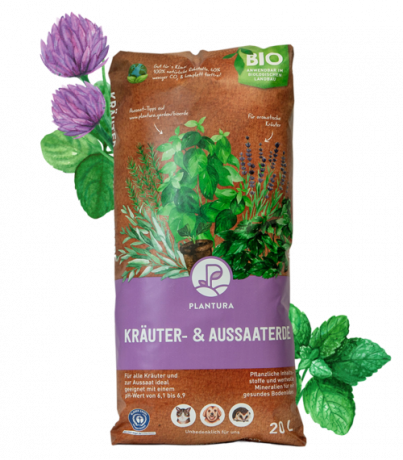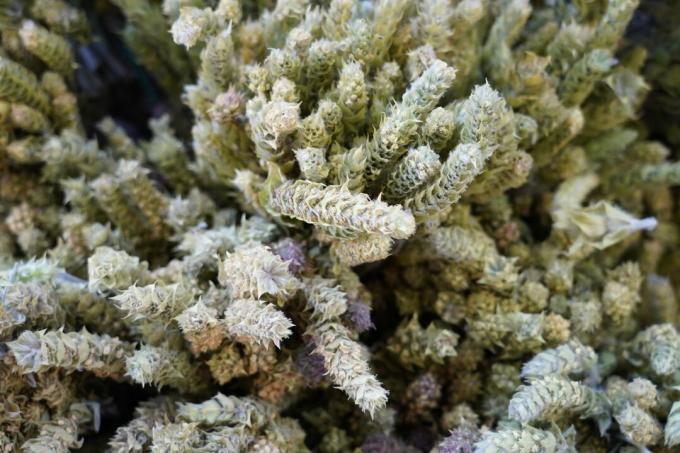Whether fresh or dried, home-grown Greek mountain tea is good for body and soul - people knew that many centuries ago.

Already ancient cultures knew the Greek mountain tea (Sideritis scardica) for its special healing effect. The mountain herb with the lemony taste is still in great demand today, but the easy-care perennial can also be easily grown at home. In this article we describe everything you need to know about Greek mountain tea as well as care and propagation through to use.
Contents
- Greek mountain tea: characteristics and origin
- Plant Greek mountain tea
- The right care
- Is Greek Mountain Tea hardy?
- propagation
- Harvesting and drying Greek mountain tea
- Uses and Effects of Greek Mountain Tea
Greek mountain tea: characteristics and origin
The mountain tea (sideritis) includes the genus of herbaceous plants, which is assigned to the mint family (Lamiaceae). Probably the most famous of the over 200
sideritisspecies from which the mountain tea is obtained Sideritis scardica, the so-called Olympic mountain tea, also known as Greek verbena or Cretan mountain tea. Its homeland is originally in the eastern Mediterranean region, where it can be found mainly in the high mountains of northern Greece, as well as in Syria and Iran. Adapted to cold altitudes, the robust mountain perennial can also feel at home in our latitudes. Others too sideritisSpecies grown as a tea plant thrive well in our climates. This is how the hardy Syrian mountain tea (sideritis syriaca), the hyssop-leaved ragweed (Sideritis hyssopifolia), the Golden Mountain Tea (Sideritis congesta) or Sideritis clandestina cultivated in our garden and boiled into a tasty tea.
Grows as a perennial herb Sideritis scardica flat-growing, it can reach a height of between 30 and 50 cm. The stalk of the Greek mountain tea has elliptical leaves that are grey-green in color and covered with a gray felt. During its flowering period from June to August, the Greek mountain tea forms light yellow, lip-shaped flowers, which are grouped in long spikes. The inflorescences of Sideritis scardica spread a lemon-like scent and serve as a rich source of nectar for various beneficial insects. The flowering is followed by the formation of many small fruits with seeds.

Plant Greek mountain tea
It is definitely worth growing the Greek mountain tea yourself: you do not need your own garden for this, because Sideritis scardica can also be easily cultivated on a terrace or balcony.
Since the Mediterranean herb is exposed to strong sun in its mountainous homeland, the Greek mountain tea should be planted in a sunny and warm location. Also preferred Sideritis scardica a dry, nutrient-poor and calcareous substrate. Adequate drainage should be ensured, especially in the bucket, to prevent root rot. A special herb soil, like ours, is suitable for pot and bed culture Plantura Organic Herb & Seed Soil. For the sake of the environment, this substrate is peat-free and, with its low nutrient content, creates ideal conditions for the development and aroma development of your Greek mountain tea. To avoid waterlogging, the soil should also be thinned with some gravel or sand and the base of the pot should be covered with a drainage layer of expanded clay.

Organic Herb & Sowing Soil 20 L
- Ideal for herbs as well as for sowing, propagating cuttings and pricking out
- Ensures aromatic herbs & strong young plants with strong roots
- Peat-free & climate-friendly: CO2-reduced organic soil made in Germany
After the last frosts, the Greek mountain tea can be planted directly in the bed in mid or late May. There should be room for a maximum of 4 to 5 plants per square meter. The optimal planting distance is about 30 cm. For pot culture, a bucket with a volume of 5 to 10 liters should be chosen.
Alternatively, it is recommended that the Greek mountain tea in rockeries or to integrate wall cracks that meet his floor requirements.

Tip: Also in the herb bed, next to Mediterranean neighbors like thyme (Thymus officinalis) or rosemary (Rosmarinus officinalis), the Greek mountain tea is doing well.
The right care
As a robust mountain herb, Greek mountain tea requires little care. The basic rule is to water only a little, but if necessary, the plant should be watered moderately. It is important to avoid waterlogging. In addition, annual repotting is very good for the vigorous herb. So that sideritisIf the plant can take root, this should be done in spring, March is best. To do this, you have to carefully dig up the roots of the plant with a digging fork and place them in a larger pot with permeable, nutrient-poor soil. Since the sideritis scardicaFertilizers can be neglected if they prefer soil that is poor in plant nutrients. A proper pruning in autumn - after the flowering period - is extremely good for the hardy herb. For this you can radically cut your Greek mountain tea up to the base of the stem. Next spring will Sideritis scardica then sprout vigorously again. For rough, frosty locations, however, it is more advisable to leave the dead herb on the plant over the winter and only cut it in spring before new growth begins.
Is Greek Mountain Tea hardy?
Adapted to the harsh mountain climate, the Greek mountain tea is quite hardy and can also hibernate outdoors at temperatures down to -23 °C. In the frosty season, it is advisable to cover it with brushwood close to the ground to shield it from the winter sun and cold. It is best to place the pot culture against a house wall that protects against cold wind and waterlogging.

propagation
The easiest way to propagate Greek mountain tea plants is by sowing. You are welcome to use your own sideritis scardicause seeds. The seed is already grown between March and May. Since the Greek mountain tea is one of the light germinators, it is important that its seeds are not covered too much with soil:
- Lightly press the seeds into a pot with sandy potting soil
- Place the plant pot in a bright place and keep it moist at 20 °C
- After germination, after about 7 – 14 days, cultivate the seedlings in a cooler place at around 15 °C
- Plant young plants in pots or beds after the last frosts from mid-May
Propagation by cuttings is also possible:
- Cut off about 15 cm of the top shoot and remove the lower half of the leaves
- Put the cutting halfway into a pot with sandy potting soil
- Place in a bright place and water directly
- Leave at room temperature and keep the substrate moist for the cutting to take root after about 2-3 weeks
- Plant young plants with roots in a sunny, barren and dry location from mid-May

Harvesting and drying Greek mountain tea
You can already harvest the Greek mountain tea when it first flowers in June. The stem, leaves and flower are used for the tea. On a warm day, you can cut off the pieces before noon. Make sure that preferably any dewdrops on the plant have already evaporated. Greek mountain tea can either be freshly brewed or bundled and hung, cut side up, to dry. For this and for storage, choose a sunny and airy place. In addition, it should be dry to prevent mold growth. Dried herb can usually be stored for several years, although it will lose flavor over time.

Uses and Effects of Greek Mountain Tea
Stems, flowers and leaves are infused into an aromatic herbal tea. The Greek mountain tea has a lemony-minty taste with a fine note of cinnamon. For the preparation, fresh or dried parts of the plant are cut up and about 5 to 10 g of them are brewed in one liter of hot water. The usual brewing time for Greek mountain tea is up to 15 minutes.
Already in antiquity Sideritis scardica picked and poured into a hot drink. Traditionally, it was drunk to calm down. Even the ancient Greeks valued Greek mountain tea for its healthy and healing effects. Nowadays, the ingredients of Greek mountain tea are assigned to the so-called adaptogenic substances, which are supposed to promote the health of the human body in various ways. These include trace elements such as zinc and potassium, various essential oils and flavonoids, which have anti-inflammatory, antiseptic and antioxidant effects. So will Sideritis scardica especially as immune-boosting plant used against colds. Greek mountain tea is also used as a remedy for gastrointestinal problems. The herb reduces inflammation in the digestive tract and also stimulates the metabolism. The psyche should also benefit from the medicinal herb: the tea promotes mental well-being by slowing down the breakdown of the messenger substance serotonin in the brain.
As a medicinal plant, Greek mountain tea is non-toxic. However, pregnant women should refrain from consuming it, since its ingredients in high doses are considered to induce labor.

If you are plagued by a cold and sore throat, you will first try to alleviate the symptoms yourself before going to the family doctor. Not only Greek mountain tea helps against a stuffy nose, the selection of herbs for colds is big.
Register now for the Garten-Post and receive great tips, seasonal trends and inspiration on everything to do with the garden from our expert every week.
